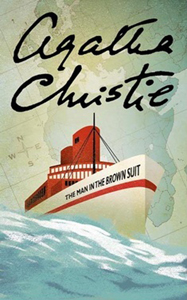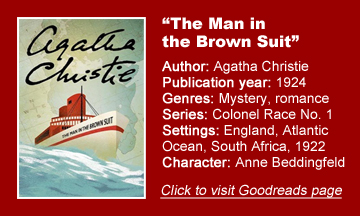Agatha Christie was very interested in large-scale international crime early in her career before she toned things down and found a groove with the Poirot and Marple formulas. The degree of success of these novels varied widely: “The Secret Adversary” bites off more than it can chew, although I adore Tommy and Tuppence; “The Big Four” is a strong candidate for Worst Christie Novel.
But in between came “The Man in the Brown Suit” (1924), a strong example of this genre and a showcase of Christie’s full skill set as she weaves between humorous whimsy and mortal threats.
A great heroine
This is categorized as the first Colonel Race novel (more on him later), but the star (and point-of-view character) is Anne Beddingfeld, an elite example of a one-off Christie heroine who seeks adventure via sleuthing. The scope and scale are particularly wide here.
It’s not quite a bildungsroman, but we do get an excellent picture of Anne’s life as a girl orphaned when her work-obsessed, money-light archaeologist father dies. Perhaps her sense of adventure comes from him, but she grasps the importance of money more and works to land a job as a newspaper correspondent on the tail of the titular man.
Through Anne’s love rectangle that includes the MITBS, Colonel Race and Parliament member Sir Eustace Pedler – not to mention several other suitors that Anne fends off – Christie has a lot to say about women’s increasing relationship options in the early 1920s.
Anne gives some thought to selecting a husband for security and comfort, but quickly rejects the idea. She knows herself well: She’ll only marry if she’s passionately in love. Her love affair with the title character is blunt in the way it toes that thin “love-hate” line, but I enjoyed it.
Competing colonels
Read upon its release, Colonel Race is one of Anne’s numerous suspects for being the (coincidentally named) “Colonel,” the leader of an ingenious international crime syndicate. He would go on to feature in “Sparkling Cyanide” and work with Poirot on a couple cases.
So most of today’s readers know he is not the culprit, but that doesn’t diminish the introduction of Race – who Anne ultimately pegs as one of those strong, silent men who is destined to be both great and unattached, because you can’t have it both ways.
“The Man in the Brown Suit” is a strong character piece all around, with an ocean vessel voyaging from England to South Africa being the perfect place for people to get to know each other. Anne befriends woman-of-the-world Suzanne Blair, whose gives us insight into old-young and rich-poor differences.
Anne also bonds with Pedler to the point that he allows his journal entries to spice up her narrative for a chapter here and there. The amusingly put-upon (or so he feels) Pedler has an entertaining array of secretaries, led by Pagett, who is so annoyingly good at his job that Pedler wants to fire him.
This is a great insight into the oddities of human thinking. It’s fun to pair Pagett with the maid in “Murder at the Vicarage” who is so bad at her job that it would be a hassle for the vicar to fire her.
A marvelous travelogue
No doubt drawing upon her own travels, Christie marvels at South Africa and other parts of the Dark Continent via young Anne. Although Christie (via Anne) assures us that this won’t be a travelogue, I nonetheless delighted in details such as Anne and Suzanne purchasing 49 fragile, carved wooden animals at train stops en route to the neighboring British colony of Rhodesia.
We get peeks at history – current events at the time of Christie’s writing – as South Africa is politically unstable. Christie sketchily tells of a labor strike in Johannesburg, and it’s also interesting to know that the country was moving toward full independence from Great Britain around this time.
I’ve said little about the mystery so far, such is the pleasure of all the other things about “The Man in the Brown Suit.” The case is a decent one – appropriately complex, but not overwhelming — although if a reader is on board solely for the compiling of clues and advancement of the case, they’ll find this to be a slow-moving novel.
But it’s hard to imagine anyone not being won over by Anne and her drive to make it in the world, her romantic passion for the title character, and – even if it’s almost a side note – her pursuit of the mysterious Colonel behind all the intrigue.
Every week, Sleuthing Sunday reviews an Agatha Christie book or adaptation. Click here to visit our Agatha Christie Zone.



